Plastic is not one single material. It’s a broad category encompassing countless variations, each tailored to meet specific needs. From durable packaging to lightweight films, plastic's versatility comes from the unique combinations of chemicals and additives—like plasticizers—that are used during production. These changes alter properties like flexibility, strength, and barrier performance, making plastic indispensable in packaging.
But plastic has a dual nature: it’s an essential material for modern packaging and a significant environmental challenge. Some plastics are recyclable, while others are not. And though traditional fossil fuel-based virgin plastic has dominated the market for decades, new alternatives are emerging. These innovations strive to retain the qualities we rely on while addressing environmental concerns. Let’s break down some of these options.
Why Plastic is Important in Packaging
Plastic is critical for packaging because it offers:
- Barrier properties: It protects against moisture, oxygen, and oils, keeping products fresh.
- Durability: It withstands wear and tear during shipping.
- Lightweight structure: It reduces transportation costs and energy use.
- Flexibility: It can mold into almost any shape or form.
- Cost: Plastic typically costs less to produce and transport compared to paper, making it a budget-friendly choice for many packaging applications.
These attributes make plastic nearly irreplaceable in certain applications. However, traditional plastics come with significant environmental drawbacks, including persistence in ecosystems and reliance on fossil fuels.
The Drawbacks of Plastic
- Environmental Impact: Most plastics take hundreds of years to degrade.
- Recycling Challenges: Contamination and material blends often make recycling difficult.
- Resource Use: Virgin plastics depend heavily on non-renewable fossil fuels.
To address these issues, innovative plastic alternatives are redefining what sustainable packaging can look like.
Exploring Sustainable Plastic Alternatives
1. Renewa™: Recycled Ocean-Bound Plastic
Pros:
- Made from plastic waste collected near coastal areas, reducing marine pollution.
- Highly durable and performs similarly to virgin plastic.
- Recyclable in most existing recycling systems.
Cons:
- May have slight variations in quality compared to virgin plastic.
- Availability depends on the supply of collected ocean-bound plastic.
Best Use: Great for applications requiring high durability and recyclability, such as shipping bags and protective films.
2. Recycled Plastic (PIR and PCR Blends)
Pros:
- Utilizes post-industrial (PIR) and post-consumer (PCR) waste, reducing reliance on virgin materials.
- Can reach up to 100% recycled content.
Cons:
- Properties may vary, with slight imperfections like small specks and a slight texture compared to virgin plastic.
- Often not recycled due to challenges in recycling systems.
Best Use: Best for applications requiring a barrier or when lowest cost is needed.
3. Compostable Plastic (Corn-Based)
Pros:
- Made from renewable corn waste, reducing dependency on fossil fuels.
- Compostable in industrial facilities, leaving no microplastic residues.
Cons:
- Limited composting infrastructure
- Lower barrier properties compared to traditional plastics, especially against moisture, and 1 year shelf life.
Best Use: Perfect for short-term use in controlled environments, like produce bags or single-use items.
4. BioLaminate™: Sugarcane-Based Plastic
Pros:
- Mimics the qualities of virgin plastic, including high barrier properties.
- Primarily made from sugarcane, a renewable resource.
- Reduces carbon footprint compared to fossil fuel-based plastic.
Cons:
- Limited availability and slightly higher cost.
Best Use: Excellent for premium applications where performance and appearance are critical, such as food packaging or luxury items.
No Perfect Solution, But Many Paths Forward
While no single material can completely replace traditional plastic, the variety of sustainable options allows companies to choose materials best suited to their specific needs. Factors like water vapor transmission, oxygen barriers, and oil resistance all play a role in determining the right fit.
How EcoPackables Can Help
At EcoPackables, we stay at the forefront of packaging innovation, offering the latest and most effective materials, from Renewa™ to BioLaminate™. We’re committed to educating and guiding you in selecting the best packaging solutions for your business. Whether you prioritize recyclability, compostability, or renewable resources, we’re here to help you navigate the complexities of sustainable packaging and make choices that align with your brand and values.

